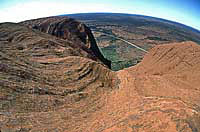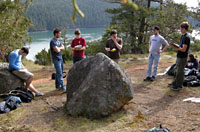
"4000 atoms counted so far this quarter"*


ESS 460/560 Lecture topics
This is the material we will cover in the class. Not every topic corresponds to an individual lecture. I'm aiming to cover the fundamentals of exposure dating by the beginning of week 5, so that we can move on to integrating cosmogenic nuclide accumulation into geomorphic models. You can download the syllabus pages for the class, or read on ...
Topics (first half)
Introduction. Exposure dating vs applications to evolving surfaces. Cosmic radiation. Primary vs secondary cosmic rays. Energy considerations. Nucleon, muon and electron-gamma components.
Nuclear reactions / mass-energy conservation relations. High and low energy interactions.
Cosmogenic nuclides. "Meteoric" nuclides vs nuclides produced in situ. Dependence of production on chemical composition. Survey of nuclides produced in air ("meteoric" nuclides) and below ground ("in-situ" nuclides).
Production rates. Production thresholds vs radioactive decay energies. Background levels in terrestrial materials. The importance of scarcity! Basics of detection methods.
Isotope accumulation - simple cases of exposed and eroding surfaces, for stable and radioactive isotopes. Quantitative consideration of the effects of half-life, production rate, erosion and/or burial rates. Introduction to geomorphic problems involving simple shielding histories.
Effects of atmospheric and geomagnetic shielding. Correction formulae. Paleomagnetic variation; effect of magnetic intensity and dipole orientation changes on nuclide production rates. Nuclide accumulation with allowance for changing production rate. Paleo-altimetry and paleomagnetically-corrected exposure ages.
Effects of target composition, sample thickness, and exposure geometry. Simple thickness and "horizon" corrections. Depth-dependence of nuclide production for flat and dipping surfaces, and arbitrary exposure geometries.
Production rate calibration. Cross-sections and nuclear models vs empirical calibration. Critical evaluation of production rate data.
Complete calculation of production rates and exposure ages.
First half ends about here ...
Depth dependence of reactions. Spallation reactions, thermal and epithermal neutron capture, muon capture, fast muon reactions. Production profiles for different nuclides. Constraints from paired measurements of spallogenic and neutron-capture nuclides.
General equation for isotope accumulation. Integration of shielding histories. Forward models for prescribed erosion and burial histories. Incorporation of time-dependent production rates. Constraints on complex exposure/burial histories from measurements of multiple nuclides. Brief comments about inverse approaches.
Cosmogenic isotope measurements - Accelerator Mass Spectrometry (AMS). Theory and practice. Sample preparation considerations. Precision and sensitivity considerations.
Notes and handouts
Date Topic Notes and handouts Lecture 1 (Introduction) Walk-through — exposure dating and a simple geomorphic model The Little Book of Geomorphology (pdf) by Bob and Suzanne Anderson; see pp 45-52 for an excellent summary of how to integrate cosmogenic nuclides into geomorphic problems. Cerling & Craig 1994 review (pdf). A bit out-of-date by now, but a good statement of the prospects for cosmogenic nuclide-based research written as the subject was getting underway.Lecture 2 Nuclear physics Notes on nuclear properties (FKMM) (pdf) Powerpoint originally assembled by Dave Argento covering cosmic rays, nuclear interactions, binding energy and the energetics of nuclear reactions, cross-sections, etc)An earlier powerpoint presentation by Dave Argento on nuclear structure & radioactivity; 580 kb ppt)
